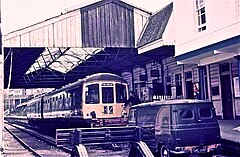British Rail Class 103
| British Rail Class 103 | |
|---|---|

A Class 103 at Kingswear station in 1972.
|
|
| In service | 1957–1983 |
| Manufacturer | Park Royal Vehicles |
| Number built | 20 sets (40 cars) |
| Formation | 2 car sets: DMBS-DTCL |
| Capacity |
DMBS: 52 second class; DTCL: 16 first and 48 second class |
| Operator(s) | British Rail |
| Specifications | |
| Car length | 57 ft 6 in (17.53 m) |
| Width | 9 ft 3 in (2.82 m) |
| Maximum speed | 70 mph (110 km/h) |
| Weight | DMBS: 33 long tons 8 cwt (74,800 lb or 33.9 t) DTCL: 26 long tons 7 cwt (59,000 lb or 26.8 t) |
| Prime mover(s) | Two BUT (AEC) 6-cylinder diesels |
| Power output | 150 bhp (112 kW) each engine |
| Transmission | Mechanical: 4 speed epicyclic gearbox |
| Braking system(s) | Vacuum |
| Coupling system | Screw-link couplings, British Standard gangways |
| Multiple working | ■ Blue Square |
| Track gauge | 4 ft 8 1⁄2 in (1,435 mm) |
The British Rail Class 103 diesel multiple units were built by Park Royal Vehicles with diesel engines by British United Traction (BUT). Ordered in the first half of 1955, 20 of these sets were built by Park Royal at the Crossley Motors works in of the ACV Group. They consisted of a power car and a driving trailer. Standard BUT equipment was fitted, with 'A' type engines.
A two-car set with 16 first class and 100 second class seats weighed just under 60 long tons, representing 1,150 lb (520 kg) a seat and had 5 hp per ton of empty weight or 4.35 hp per ton when full.
They were allocated new to the London Midland Region of British Railways, spending most of their time at Chester. The first deliveries went to traffic in the Llandudno area, allocated to Llandudno Junction in early 1958. This is believed to be an indirect consequence of unit shortages as a result of bogie problems with the BRCW units [Trains Illustrated 1958]. By the end of the same year they were all allocated to Ryecroft for the routes radiating from Walsall. These services were dieselised on 17 November that year [Trains Illustrated Jan 1959 p53]. The last four sets were transferred to the Western Region of British Railways, and worked in the Cardiff and Reading areas. Although considered non-standard, owing to their bodywork construction, their use of standard BUT equipment and blue square coupling code allowed them to operate with other classes.
...
Wikipedia
